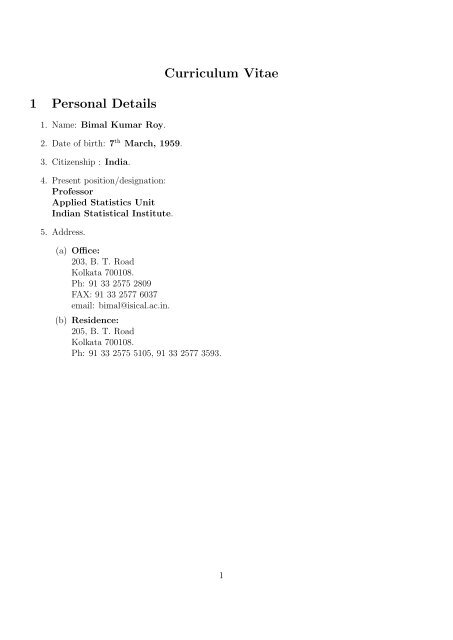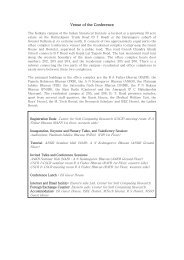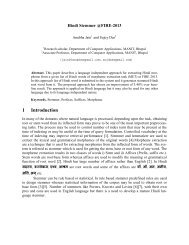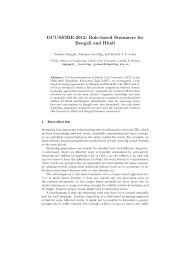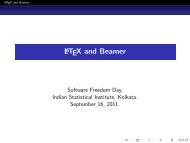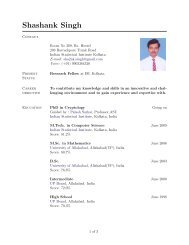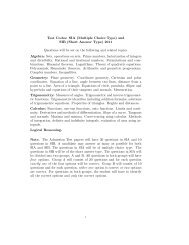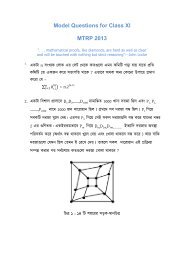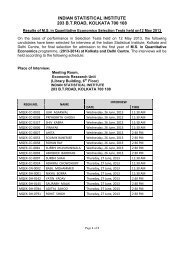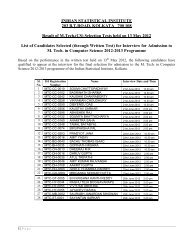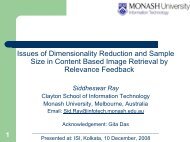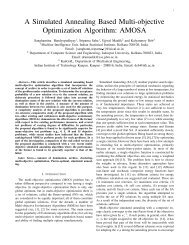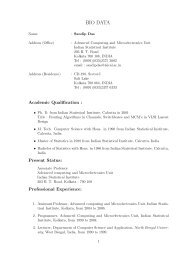Curriculum Vitae 1 Personal Details - Indian Statistical Institute
Curriculum Vitae 1 Personal Details - Indian Statistical Institute
Curriculum Vitae 1 Personal Details - Indian Statistical Institute
Create successful ePaper yourself
Turn your PDF publications into a flip-book with our unique Google optimized e-Paper software.
<strong>Curriculum</strong> <strong>Vitae</strong>1 <strong>Personal</strong> <strong>Details</strong>1. Name: Bimal Kumar Roy.2. Date of birth: 7 th March, 1959.3. Citizenship : India.4. Present position/designation:ProfessorApplied Statistics Unit<strong>Indian</strong> <strong>Statistical</strong> <strong>Institute</strong>.5. Address.(a) Office:203, B. T. RoadKolkata 700108.Ph: 91 33 2575 2809FAX: 91 33 2577 6037email: bimal@isical.ac.in.(b) Residence:205, B. T. RoadKolkata 700108.Ph: 91 33 2575 5105, 91 33 2577 3593.1
2 Academic and Professional <strong>Details</strong>1. Qualifications.2. Positions Held.Degree Subject Institution Year RemarkB.Stat Statistics <strong>Indian</strong> <strong>Statistical</strong> <strong>Institute</strong> 1978 2nd rankM.Stat Statistics <strong>Indian</strong> <strong>Statistical</strong> <strong>Institute</strong> 1979 1st rankPhD Combinatorics Univ. of Waterloo, Canada 1982 completedin 2 years(a) Assistant Professor, Department of Computer Science, State University ofNew York at Utica, 1982 – 1984.(b) Lecturer, Computer Science Unit, <strong>Indian</strong> <strong>Statistical</strong> <strong>Institute</strong>, 1984 – 1989.(c) Associate Professor, Computer Science Unit, <strong>Indian</strong> <strong>Statistical</strong> <strong>Institute</strong>,1989 – 1997.(d) Associate Professor, Department of Computer Science, State University ofNew York at Utica, 1990 – 1991. (on leave from the <strong>Indian</strong> <strong>Statistical</strong> <strong>Institute</strong>).(e) Professor, Applied Statistics Unit, <strong>Indian</strong> <strong>Statistical</strong> <strong>Institute</strong>, 1997 till date.3 Awards1. National Academy of Science, India – Reliance Platinum Jubilee Award for innovationin Physical Sciences, 2007.2. IBM Faculty Award 2007 for research, teaching and initiative in Cryptology and Security.2
4 Thesis Supervision4.1 PhD SupervisionThe details of the supervision of research fellows in different areas are given below.RF in Statistics.1. On repeated measurement designs and symmetric balanced squares, 1992.2. On application of combinatorics in fault tolerant VLSI designs, 2001.RF in Computer Science.3. On application of combinatorial structures to key predistribution in sensor networksand traitor tracing, 2009.4. On key pre-distribution in sensor networks, 2008.5. On construction and properties of cryptographic hash functions, expected 2010.6. On construction of visual cryptographic schemes, 2004.7. On construction of Boolean functions with cryptographic properties, 1999.RF in Mathematics.8. On designs of iteration on hash functions and its cryptanalysis, 2005.RF in <strong>Statistical</strong> Applications.The degrees were awarded by Jadavpur University.9. On environmental sciences (co-supervisor), 2008.10. On statistical methods in analytical chemistry (co-supervisor), 1991.4.2 Master’s StudentsSupervised over fifty masters dissertation in different curricula such as Master of Statistics, Masterof Technology in Computer Science, Master of Technology in Quality, Reliabilityand Operations Research.3
5 Membership of Professional Bodies and Roles1. Member of the UNESCO Technical Advisory Committee for Asia-Pacific region, since2009.• Involved in statistical assessment of literacy of the developing nations in Asia-Pacificregion and to advice concerned nations on infrastructural requirements for literacy improvement.Currently involved with Palestine and Laos.2. Member of program advisory committee for mathematical sciences of the Department ofScience and Technology (DST), India, 2007 onwards.• Study and recommend for approval research/project nation-wide proposals in pure andapplied mathematics, statistics, operations research and theoretical computer science.• Security assessment of the entire wireless communication systems, including main network,mobile devices and key management.3. Member of Technical Advisory committee for surveys, Reserve Bank of India from 2007.• Streamlined inflation expectation survey that has impact on RBI’s monetory policy.• To help in building housing price indices for different segments such as big metropolis,small towns, villages, etcetra.4. Member of the Governing Council of the National Sample Survey Organization (NSSO),2002–2006.• Designing the national level surveys for all the rounds in the said period, advice on datavalidation, compilation and analysis.• Chairman of a working group to study possible under-estimation of population total viaNSSO surveys as compared to census.5. Member of the board for security and assurance, National Association of Software andService Companies (NASSCOM), from 2004.• Provided input to all software companies to formulate policies on information security.• Participated in the formulation of the Information Technology Act, 2006.6. Founder-Secretary of the Cryptology Research Society of India, from its inception in2001.• Leadership role in promoting the science of modern cryptology in academia and governmentagencies.• Organising an international conference series called Indocrypt since 2000 which has becomeone of the leading conferences dedicated to the science of cryptology.4
• Inviting doyens of cryptology, such as Professors Adi Shamir, Claus P. Schnorr, VincentRijmen, Bart Preneel, to India for talks and interactions with the <strong>Indian</strong> cryptologycommunity.• Organising national-level workshops for young faculty and researchers to disseminate thestate-of-the-art knowledge in the subject.• Organising national-level instructional workshops for teachers of cryptology.5
6 Sponsored Projects6.1 CryptologyPrincipal investigator for all the projects below.1. High-Budget Projects(a) Strategic Japanese-<strong>Indian</strong> Co-operative Programme on “Multidisciplinary ResearchField which combines Information and Communications Technology withOther Fields”, 2009-2012.• Joint research on network security, key management for plausible adoption by the<strong>Indian</strong> and Japanese governments.(b) Evaluation of a stream cipher designed by KDDI, Tokyo, Japan, 2006–2007.• Assess and validate an LFSR based stream cipher to be used for mobile communication.(c) Research and development of cryptographic primitives, funded by Departmentof Information Technology, 2006-2011.• Develop indigenous cryptosystems involving encryption and hash function for use bydifferent government agencies.• New research in the areas of Boolean functions, identity-based encryption, signcryption,visual cryptography, sensor networks with potential for development ascommercial products.(d) Development of pairing based cryptographic protocols, funded by Departmentof Information Technology, 2003–2006.• Development of new protocols using bilinear maps realised through Tate pairings.(e) Cryptanalysis of Complex LFSR based stream ciphers, funded by ScientificAnalysis Group of the Defence Research and Development Organization, 2000-2002.• Complete cryptanalysis of very general LFSR based combiner models where thecombining function has low correlation immunity which is the case in reality.(f) Cryptanalysis of LFSR based stream ciphers, funded by Defence Research andDevelopment Organization, 1998–2000.• Cryptanalysis of specified combiner models.2. Other Projects. All the projects below have lead to products to be used by the concernedagencies.(a) Construction of Boolean functions with cryptographic properties, funded byCAIR, Defence Research and Development Organization, 2000-2001.(b) Study of connection polynomials over GF (2), funded by CAIR, Defence Researchand Development Organization, 2001-2002.6
(c) Study of connection polynomials over GF (2 k ), funded by CAIR, Defence Researchand Development Organization, 2005-2006.(d) Development of indigenous stream cipher for <strong>Indian</strong> Navy, funded by WESEE,<strong>Indian</strong> Navy, 2001-2002.(e) Development of visual cryptographic schemes, funded by WESEE, <strong>Indian</strong> Navy,2005-2006.(f) Construction of UOWHF, funded by WESEE, <strong>Indian</strong> Navy, 2005-2006.(g) Development of visual cryptographic schemes, funded by ADRIN, <strong>Indian</strong> SpaceResearch Organization, 2002-2004.(h) Design of new stream cipher, funded by SHOGHI.(i) Design of self-synchronizing stream cipher, funded by Sutech,6.2 Projects on Statistics1. Principal investigator of a project on “Tracer Study of ITI Trainees” funded by DirectorateGeneral (Education and Training), 1994–1996.• Employability of ITI trainees in government and private industries as skilled labours withemphasis on region and trade-wise variations.• Provide input for improvement of ITI training program for better employability of thetrainees.2. Principal investigator of a project on “Rural Indebtedness” funded by the Reserve Bankof India, 1993–1995.• Resolved a dispute that arose from contradictions between NSSO’s all-India Debt andInvestment Surveys and RBI bulletin on rural credit disbursements.3. Principal investigator of a project on “Garbage Management of Calcutta MunicipalCorporation” funded by Calcutta Municipal Corporation, 1989–1990.• Solved the challenging problem of estimation of garbage accumulation in the CalcuttaMunicipal Corporation area with seasonal variations.• Optimal routing of vehicles for garbage clearance within a given time-frame with theavailable resources, including vehicles and manpower.4. Team member of a project on “Methods for Estimating Tiger Population in the Sunderbans”funded by the Government of West Bengal, 2006-2007.5. Team member of a project on “Methods for Estimating Elephant Population in Jaldapara”funded by the Government of West Bengal, 2006–2007.6. Team member of a project on “Life Distribution of Currency Notes” funded by theReserve Bank of India, 2002–2003.7
7 International Recognition7.1 International Academic Liasion1. Since 2001, international faculty for supervising master’s degree cadets of École spécialemilitaire de Saint-Cyr, France.2. Currently an advisor for setting a centre for cryptography and information security at KhalifaUniversity, Abu Dhabi for the government of the United Arab Emirates.3. Since 2001, member of the International Scientific Advisory Committee of the Centrefor Applied Cryptography Research, University of Waterloo, Canada.7.2 Invited Talks in Major International Professional Conferences1. At the Australasian Conference on Information Security and Privacy, Melbourne, 2002.2. At the IEEE International Workshop in Information Theory, Bangalore, 2003.3. At the IEEE International Workshop in Information Theory, Gdansk, Poland, 2008.4. At Indocrypt, Chennai, 2004.5. At Indocrypt, IIT-Kharagpur, 2008.6. Special invited talks at the Chinese Academy of Science, Beijing, 2007.7.3 Editorial Work1. Associate Editor, Journal of Ad Hoc & Sensor Wireless Networks, 2009 onwards.2. Associate Editor, Journal of Wireless Sensor Networks, 2009.3. A.R. Rao, D.K. Ray-Chaudhuri and Bimal K. Roy (editors). Special Issue of DiscreteMathematics in honour of R.C. Bose, 2006.• Discrete Mathematics very selectively publishes special issues and it is a great internationalhonour to be an editor for such issues.4. Bimal K. Roy (editor). Advances in Cryptology - ASIACRYPT 2005, Volume 3788 ofLecture Notes in Computer Science, 11th International Conference on the Theory andApplication of Cryptology and Information Security, Chennai, India, December 4-8, 2005,Proceedings Springer 2005.5. Bimal K. Roy, Willi Meier (editors) Volume 3017 of Lecture Notes in Computer Science,Fast Software Encryption, 11th International Workshop, FSE 2004, Delhi, India, February5-7, 2004, Revised Papers Springer 2004.8
• Both Asiacrypt and FSE are flagship conferences of the International Association forCryptologic Research and a person is invited to chair such conference only once in alifetime. Chairing two of these conferences is a rare honour shared only a handful ofpersons internationally.6. Bimal K. Roy, Eiji Okamoto (editors). Progress in Cryptology - INDOCRYPT 2000, Volume1977 of Lecture Notes in Computer Science, First International Conference inCryptology in India, Calcutta, India, December 10-13, 2000, Proceedings Springer 2000.• This was the first international cryptology conference in India.7. Bimal K. Roy, Nicolas Sendrier (editors). Progress in Cryptology - INDOCRYPT 2009, Volume5922 of Lecture Notes in Computer Science, Tenth International Conference inCryptology in India, Proceedings Springer 2009.8. Bimal K. Roy (editor). Special Issue on Cryptology of the Journal of the <strong>Indian</strong><strong>Statistical</strong> Association, Volume 42, 2004.• This was to motivate the statistics research community about applications of statisticsin cryptology.9
8 Invited International Visits8.1 Regular visitors to the following places1. French Military Academy, Rennes, France.2. INRIA-Paris, France.3. University of Waterloo, Canada.4. Carleton University, Canada.5. University of Ottawa, Canada.6. Chinese Academy of Sciences, P.R.C.7. University of Science and Technology, Hong-Kong.8. Kyushu University, Japan.9. Tokyo University, Japan.8.2 Other visits1. Lund University, Sweden.2. National University of Singapore, Singapore.3. Warshaw Polytechnic, Poland.4. Gdansk Polytechnic, Poland.5. North Carolina State University, USA.6. Katholieke Universiteit, Leuven, Belgium.10
9 Academic Administration at ISI1. Dean of Studies, 2006-2008.• Initiated the introduction of special quotas for the underprivileged section of the society(as per the Government of India policies).• Initiated pro-active measures leading to an increased intake in the number of studentsand research scholars.• Initiated cultural and sports programme for the students including a drama festival anda football competition.• Initiated interaction of the students with captains of the industry such as the CEO ofInfosys and Vice President & General Manager of IBM Global Services in India.• Initiated funding from Microsoft Research India for awards to bright young faculty ofthe institute and for providing international travel support to both PhD students andfaculty members.• Initiated measures to modernise the dean’s office operations including the starting ofOCR based processing of admission test answerscripts.2. Professor-in-Charge, Applied Statistics Division, 2000-2002, 2008-2010.3. Head, Applied Statistics Unit, 2005-2006.4. Warden of all the students’ hostels, 1987-1998.5. Founder of the placement committee.• Served as the convenor for the period 1985-1992.• Carried out negotiations with different industries resulting in making ISI graduates asought-after brand-name in the relevant industries.11
10 List of Publications10.1 Journal Publications1. Sushmita Ruj and Bimal Roy. Key Predistribution Using Combinatorial Designs for GridgroupDeployment Scheme in Wireless Sensor Networks. ACM Transaction on SensorNetworks, Volume 6, Number 1, 2009.2. Sushmita Ruj and Bimal Roy. Revisiting Key Predistribution using Transversal Designsfor a Grid-based Deployment Scheme: International Journal of Distributed SensorNetworks. Volume 5, Number 6, pp 660-674, 2009.3. Sushmita Ruj and Bimal Roy. Key Predistribution using Partially Balanced Designs in WirelessSensor Networks: International Journal of High Performance Computing andNetworking (IJHPCN), 2009 (To appear).4. Sushmita Ruj and Bimal Roy. Key Distribution Schemes Using Combinatorial Designs ToIdentify All Traitors. Congressus Numerantium, Volume 193, pp 195-214, 2008.5. Sushmita Ruj, Subhamoy Maitra and Bimal Roy. Key Predistribution using TransversalDesign on a Grid of Wireless Sensor Network: Ad Hoc & Sensor Wireless Networks.Volume 5, Number 3-4, pp 247-264, 2008.6. Avishek Adhikari Mausumi Bose, Dewesh Kumar and Bimal K. Roy. Applications of PartiallyBalanced Incomplete Block Designs in Developing (2, n) Visual Cryptographic Schemes.IEICE TRANS. FUNDAMENTALS. Vol. E90-A, No. 5, May 2007.7. Dibyendu Chakrabarti, Subhamoy Maitra, Bimal K. Roy. A key pre-distribution scheme forwireless sensor networks: merging blocks in combinatorial design. International Journalof Information Security, 5(2): 105-114 (2006).8. M. Amir Hossain, Mrinal Kumar Sengupta, Sad Ahamed, Mohammad Mahmudur Rahman,Debapriya Mondal, Dilip Lodh, Bhaskar Das, Bishwajit Nayak, Bimal K. Roy, AmitavaMukherjee, and Dipankar Chakraborti. Ineffectiveness and Poor Reliability of ArsenicRemoval Plants in West Bengal, India. Environmental Science & Technology, 2005,39,4300-4306. Highlighted in News Section of Nature Magazine: Arsenic - free water still aPipe dream. NATURE, Vol. 436, page 313, 21st July 2005.9. Dibyendu Chakrabarti, Subhamoy Maitra, Bimal K. Roy: Clique Size in Sensor Networks withKey Pre-distribution Based on Transversal Design. International Journal of DistributedSensor Networks, Volume 1, No. 3-4, Pages 345–354, 2005.10. Bimal K. Roy and Sarbani Palit. Some statistical attacks on stream cipher cryptosystems.Journal of <strong>Indian</strong> <strong>Statistical</strong> Association, 42 (2004), no. 1, 1–34.11. Soumen Maity, Amiya Nayak, Bimal K. Roy: Characterization of catastrophic faults in twodimensionalreconfigurable systolic arrays with unidirectional links. Information ProcessingLetters, 92(4): 189-197 (2004).12
12. Soumen Maity, Amiya Nayak, Bimal K. Roy: On characterization of catastrophic faults intwo-dimensional VLSI arrays. Integration, 38(2): 267-281 (2004).13. Bimal Roy and Sourav Mukhopadhyay. <strong>Statistical</strong> Cryptanalysis on Block Cipher. Journalof the <strong>Indian</strong> Society for Probability and Statistics, Vol. 7, 2003.14. Soumen Maity, Bimal K. Roy, Amiya Nayak: On enumeration of catastrophic fault patterns.Information Processing Letters, 81(4): 209-212 (2002).15. Tridib K. Dutta and Bimal K. Roy. Construction of some repeated measurements designs,Journal of <strong>Statistical</strong> Planning and Inference, 95 (2001) pp. 283–291.16. Soumen Maity, Tridib K. Dutta, Bimal K. Roy. Construction and efficiency of some repeatedmeasurements designs. Journal of the <strong>Indian</strong> <strong>Statistical</strong> Association, 39 (2001), no. 2,137–160.17. Soumen Maity, Bimal K. Roy, Amiya Nayak: Enumerating catastrophic fault patterns inVLSI arrays with both uni- and bidirectional links. Integration, 30(2): 157-168 (2001).18. Soumen Maity, Bimal K. Roy. Construction of some classes of optimal repeated measurementsdesigns. Calcutta <strong>Statistical</strong> Association Bulletin, 50 (2000), no. 197-198, 33–42.19. Subhamoy Maitra, Bimal K. Roy and Palash Sarkar. Ciphertext only attack on LFSR basedencryption scheme. Calcutta <strong>Statistical</strong> Association Bulletin, 49 (1999), no. 195-196,239–254.20. Dipankar Basu, Kumar K. Mahalanabis and Bimal Roy. Application of least squares methodin matrix form: simultaneous determination of ibuprofen and paracetamol in tablets. Journalof Pharmaceutical and Biomedical Analysis, Volume 16, Issue 5, January 1998, Pages809-812.21. Tridib K. Dutta and Bimal K. Roy. Construction of symmetric balanced squares, Ars Combinatoria,Vol. 47 (1997) pp. 49-64.22. Palash Sarkar, Bimal K. Roy, Pabitra Pal Choudhury. Polynomial division using left shiftregister Computers & Mathematics with Applications, 35 (6): 27-31 MAR 1998.23. Palash Sarkar and Bimal K. Roy. Construction of nearly balanced uniform repeated measurementdesigns. Calcutta <strong>Statistical</strong> Association Bulletin, 45 (1995), no. 179-180,235–243.24. Indranil Ojha and Bimal K. Roy. Opsearch, Vol.31, no.4, 1994, pp 279–295.25. Tridib K. Dutta, Bimal K. Roy. Construction of strongly balanced uniform repeated measurementsdesigns: a new approach, Sankhya, 54, pp 147–153, 1992.26. Dipankar Basu Kumar K. Mahalanabis and Bimal Roy. Simultaneous spectrophotometricdetermination of metronidazole and furazolidone with multi standard addition and a leastsquaresmethod, Analytica Chimica Acta, Volume 249, Issue 2, 1991, Pages 349-352.13
of the analyses even more dispersed, resulting in wider confidence intervals. This means, in reality,some communities may be subject to even higher proportions of people missing in jail across allage groups. With rates of incarceration increasing in the NT in recent years, the potential social,economic and demographic effects may be devastating. With the prison population for Indigenouspeople being significantly older than the overall Indigenous population, those with social, culturaland knowledge capital are likely missing. Clearly, at any point in time, a number of fathers andgrandfathers may be missing from individual communities and their families.There is, however, not only the issue of people missing at any point in time. The prison populationis constantly churning as individuals are released and others ‘join’ the prison population. Withvarying sentence lengths, this means significant churn is likely for individual communities as aresult of the incarceration of residents. The latest Prison Census (ABS, 2014a), for example,indicates 77.2% of Aboriginal and Torres Strait Islanders in the NT experienced prior imprisonmentand the rate is rising.A range of demographic impacts might be anticipated given the worrying numbers presented inthis brief. Besides a rise in single parent households and a reduction in the number of newborns(from women and men in their prime child bearing years being in prison), incarceration representsanother form of temporary out ‘migration’, with flow-on effects for the community. In the light ofour research findings, we discovered such flow-on effects can be of social and economic nature.These range from adverse health effects, to financial distress and social dysfunction. The literaturealso highlights imprisonment can have inter-generational and lasting effects, particularly with thehigh amount of men (and possibly fathers) absent from their community taking with them theopportunity to be role models, father figures and mentors for their community. Various prisonprograms have attempted to address this issue in Australia, such as the fathering program atHakea Prison in Canning Vale, Western Australia (Western Suburbs Weekly, 2009), and theBrothers Inside project at the Cessnock Correctional Centre in New South Wales. These highlightthe importance of the father role in communities and the significance of communication betweenincarcerated men and their children (Stuart & Hammond, 2010).The large increases in the Indigenous incarceration rate in the Northern Territory in recent years(and to a greater extent, also in the rest of Australia) have also fuelled debates about the reintroductionof the mandatory sentencing and its effects on the rate of incarceration. Seniormembers of the Northern Territory's legal fraternity, for instance, warned mandatory sentencingin the Territory has negative effects, particularly on the Aboriginal community (Stein, 2014).Besides mandatory sentencing, other reasons for an increase in the incarceration rate wereexplored. Others have argued increasing incarceration rates are a long-term societal outcomefrom a growing punitive public attitude towards crime (Australian Legal and Constitutional AffairsReference Committee, 2013). Tough-on-crime policies are increasingly evident, including increasedsentences, the increased use of incarceration for non-violent offenses (such as drugs, breaching ofthe peace, and traffic violations) and changes to the use of bail and remand so less offendersreceive bail, or are remanded for technical breaches of bail (Australian Legal and ConstitutionalAffairs Reference Committee, 2013).Who’s missing? page 13
40. Dibyendu Chakrabarti, Subhamoy Maitra, Bimal K. Roy: A Key Pre-distribution Scheme forWireless Sensor Networks: Merging Blocks in Combinatorial Design. Volume 3650 of LectureNotes in Computer Science, Springer, ISC 2005, pp 89–103.41. Dibyendu Chakrabarti, Subhamoy Maitra, Bimal K. Roy: Clique Size in Sensor Networkswith Key Pre-distribution Based on Transversal Design. Volume 3741 of Lecture Notes inComputer Science, Springer, IWDC 2005, pp 329-337.42. Soumen Maity, Amiya Nayak, Bimal K. Roy: Reliability of VLSI Linear Arrays with RedundantLinks. Volume 3326 of Lecture Notes in Computer Science, Springer, IWDC 2004,pp 326–337.43. Avishek Adhikari, Tridib Kumar Dutta, Bimal K. Roy: A New Black and White VisualCryptographic Scheme for General Access Structures. Volume 3348 of Lecture Notes inComputer Science, Springer, INDOCRYPT 2004, pp 399–413.44. Sarbani Palit, Bimal K. Roy, Arindom De: A Fast Correlation Attack for LFSR-Based StreamCiphers. Volume 2846 of Lecture Notes in Computer Science, Springer, ACNS 2003, pp331–342.45. Bimal K. Roy. Summarizing Recent Results on Finding Multiples of Primitive Polynomialsover GF(2). Information Theory Workshop, 2002.46. Bimal K. Roy: A Brief Outline of Research on Correlation Immune Functions. Volume 2384of Lecture Notes in Computer Science, Springer, ACISP 2002, pp 379–394.47. Soumen Maity, Bimal K. Roy and Amiya Nayak. Identification of optimal link redundancyfor which a given fault pattern is catastrophic in VLSI linear arrays. Congr. Numer., 151(2001), pp 41–52.48. Sarbani Palit, Bimal K. Roy: Cryptanalysis of LFSR-Encrypted Codes with Unknown CombiningFunction. Volume 1716 of Lecture Notes in Computer Science, Springer, ASI-ACRYPT 1999, pp 306–320.49. Palash Sarkar, Bimal K. Roy, Pabitra Pal Choudhury: VLSI Implementation of ModuloMultiplication Using Carry Free Addition. VLSI Design 1997, pp 457–460.15


